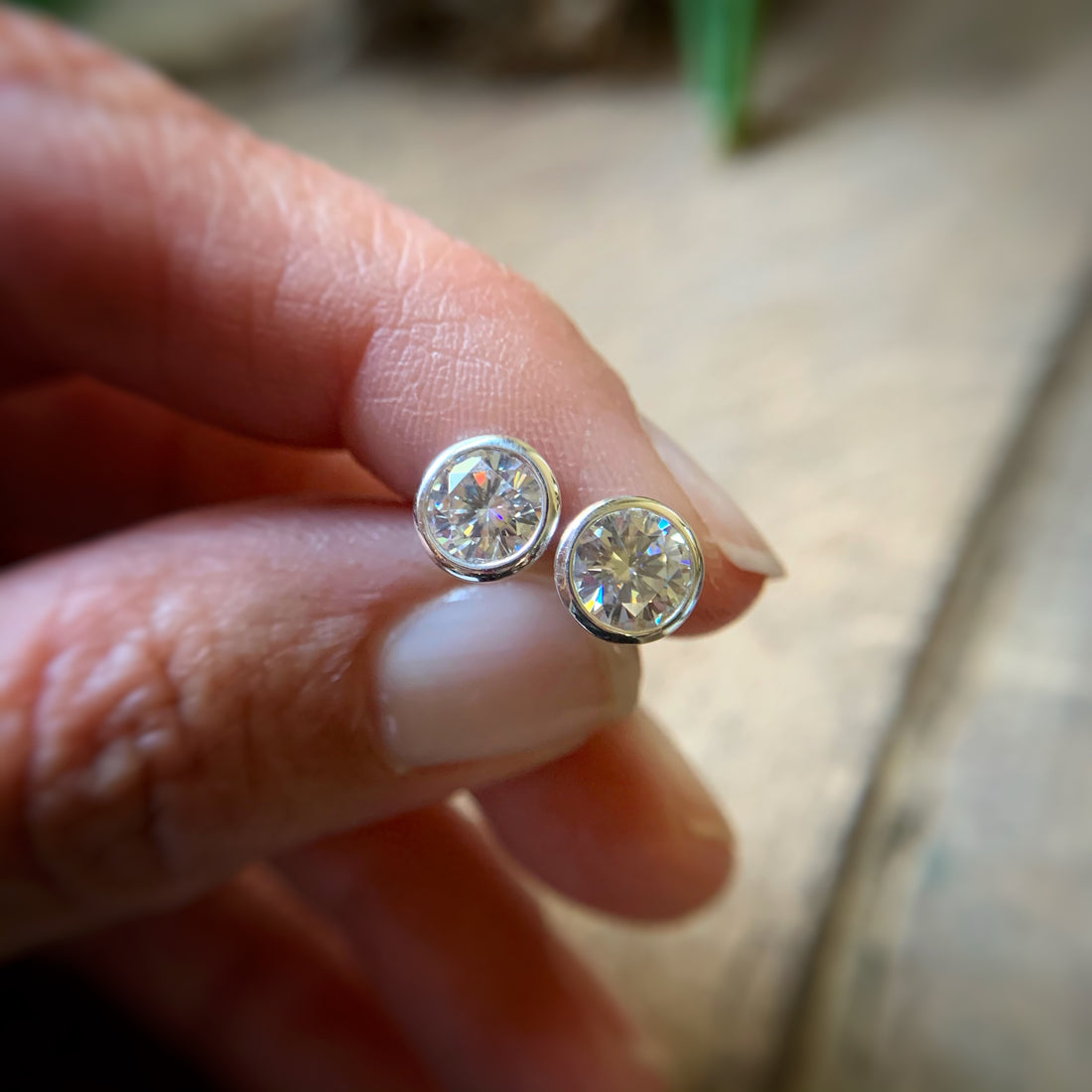
What the heck is the difference between diamond, moissanite and CZ??
I get asked this all the time, what the heck is the difference between the three stones we hear SO much about? Diamond, moissanite and cubic zirconia all look similar but there are differences that affect the look and the price of your jewelry and you should know the differences, and similarities, before you spend.
Before we start, I need to get some vocabulary words defined for you. Ready?
Refractive index: measures the difference between the speed of light in air and the speed of light in a stone. WHAT? I know. What the heck does that mean? Basically, every stone has a unique refractive index (RI). The higher the RI, the more light the facets can return to you eye so...it's more sparkly. I think they should call it the "sparkle index" but nobody asked me so....
Hardness: this is the resistance to scratching
Toughness: this is the resistance to chipping
OK...let's begin.
Diamond

We all know what a diamond is. Diamonds come in many colors, shapes and sizes. Diamonds are graded based on their colorlessness (a scale from D-Z, D being the best) and their clarity (F-I3, F being the best) Natural diamonds are mined out of the earth, they are made of carbon and they have a hardness of 10...which is the hardest substance on earth. Diamonds, however, can and do chip and break under certain circumstances so they aren't indestructible. Diamonds have a RI of 2.417, which means they are very sparkly. Diamonds are mostly cut by humans and are cut in such a way as to retain weight...because diamonds are sold by the carat, a unit of weight reserved for gemstones. When a cutter gets a rough crystal to cut, everything they cut away is lost money so the cutter tries to make the prettiest diamond they can while retaining the most weight from the original crystal. This is why diamond cutting proportions vary widely and can affect the look of a diamond even more than the color or clarity (that is another blog post...for another day). Diamonds are outrageously expensive because of the labor that is involved in the mining, cutting and marketing of diamonds. They are also viewed by many people as being rare and special. People are sentimental about diamonds and that is great. I get it. But the longer I work in the industry and the more I see and hear about diamonds...the more I love......
Moissanite

Moissanite was, at one time, an extremely rare mineral made of silicone carbide that was discovered in, of all places, Arizona in 1893. The guy who discovered it actually thought it was diamond but...he was wrong. HA! In 1998 Charles and Colvard received a patent to sell man made moissanite and year after year, moissanite got more popular. Like all innovation, it was a rocky start. Moissanite started out being a little too yellow but the technology improved year by year to what we have today, a wonderful alternative to a diamond. Moissanite comes mostly in the D-H color range (colorless to near colorless) and is starting to be available in blues and pinks. Moissanite is naturally free of large inclusions and is usually graded in the VS to VVS range (which is awesome). Moissanite's RI is 2.65 - 2.69 which makes it THE sparkliest gemstone on the planet. Because moissanite is made in a lab, it is cut by machines and sold by its measurements, which is in millimeters. And, because it's cut by machines that aren't concerned with the weight loss to the original crystal, they are perfectly proportioned for maximum beauty. Moissanite is also very close in hardness to a diamond, with rating of 9.25. The toughness is similar as well, it will chip under the same circumstances as a diamond. Moissanite came onto the market with some pretty high prices but now it is a VERY economical alternative to a diamond. It's impossible to tell the difference without a diamond tester or a microscope. And who carries those around?
Cubic Zirconia
Cubic Zirconia (CZ) is a man made form of zirconium dioxide and is mostly sold as a colorless stone. CZ has a hardness of 8 and a refractive index of 2.15, both much lower than moissanite or diamond. Honestly, CZ is a very inexpensive substitute for diamond and, because it doesn't look great, I rarely use it. It scratches and breaks more easily and just cannot sparkle like either of the above mentioned stones.
In summary
I hope this helps you demystify the difference between these three stones. This is just a basic overview but, hopefully, enough information to help you make a decision when the time comes for you to make a purchase. If I can ever answer any further questions, please reach out and ask!
